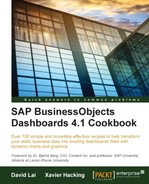The History component makes it possible to plot a value in a chart that changes in real time, while preserving its historical data. If that sounds confusing, think about the stock market charts that track the fluctuation of a stock price. At the start of the day, the line in such a chart is short, while at the end of the day the complete trend of the stock price for that day is shown. This recipe will show you how to set up this kind of functionality in your dashboard.
- Drag a Line Chart component, History component from the Other category, and a Horizontal Slider component into the canvas.
- Select the Horizontal Slider component and bind the Data field to the spreadsheet cell B1.
- Now select the History component and bind its Data field to the spreadsheet cell B1.
- Bind the Data Destination field to the spreadsheet range B3:J3.
- Go to the Line Chart component. Bind the Data | By Range field to the spreadsheet range B3:J3.
- Your setup should now look like what is shown in the following screenshot:

- Hit the Preview button and test the dashboard. Each time you move the slider, a new value should be plotted in the chart:

The History component picks up a value from a certain source cell (cell B1 in this recipe) and pastes it in a horizontal or vertical range of cells, which in fact store the history of the value. These cells are bound to a chart and so a real-time changing graph is created.
The History component has, besides binding to the source and destination cells, only one other setting. You can determine when a value should be pasted to the destination cells. This can be either when the data changes or on an interval of a certain number of seconds. This component works in the background and will therefore not be shown during runtime.
If you need more series of real-time changing values in your chart, just use more History components to accomplish this.
Another important feature is that in some cases, we can use the History component to remember values from a query so that we can avoid re-running queries when we need to look at past data from past queries.
